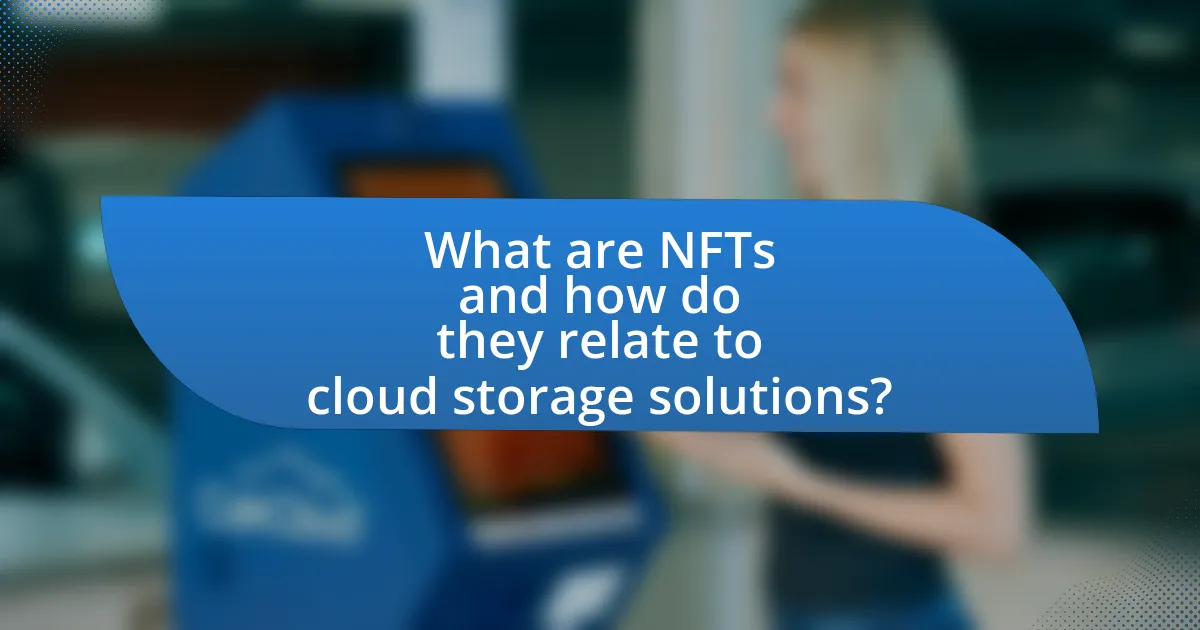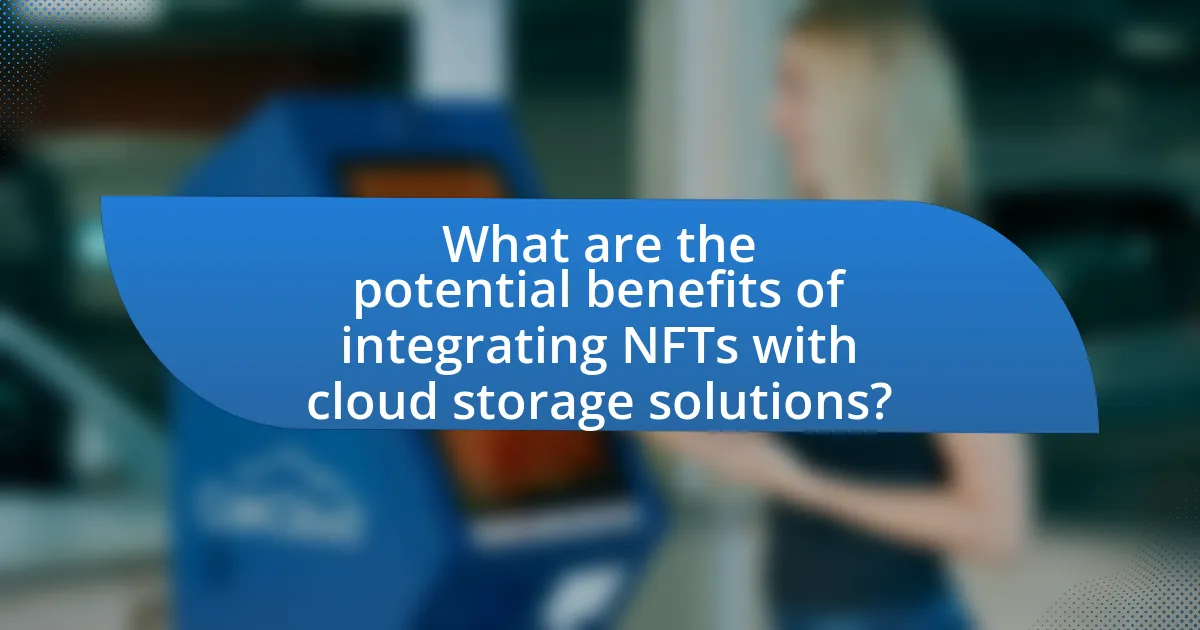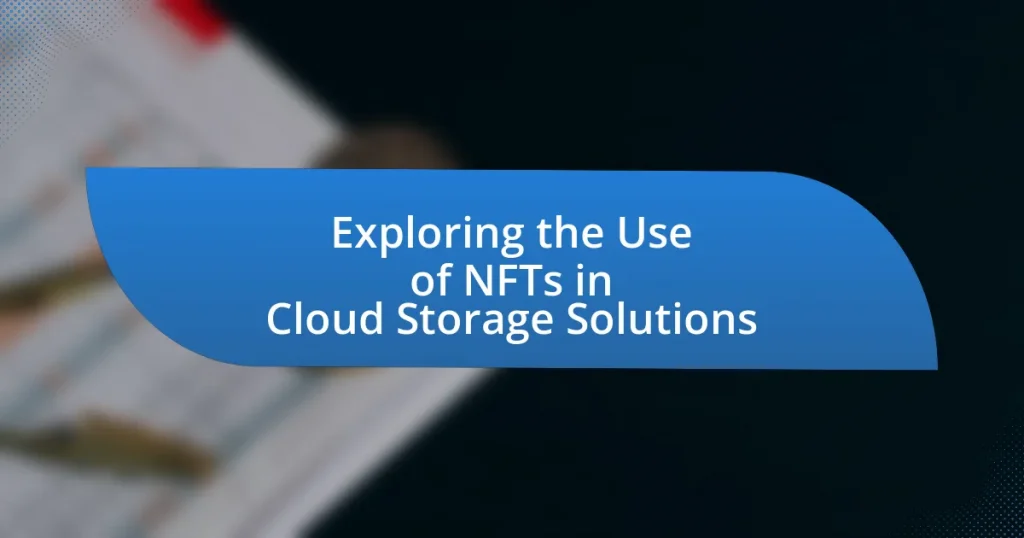The article explores the integration of Non-Fungible Tokens (NFTs) within cloud storage solutions, highlighting their role as unique digital assets that verify ownership and authenticity through blockchain technology. It discusses how NFTs enhance data security, accessibility, and integrity in cloud environments, while also addressing challenges such as scalability, interoperability, and legal concerns. Key characteristics of NFTs, their impact on data management, and best practices for secure implementation in cloud storage are examined, providing a comprehensive overview of the benefits and complexities associated with this emerging technology.

What are NFTs and how do they relate to cloud storage solutions?
NFTs, or Non-Fungible Tokens, are unique digital assets that represent ownership of a specific item or piece of content on a blockchain. They relate to cloud storage solutions by providing a method for securely storing and verifying ownership of digital files, such as art or music, in a decentralized manner. This integration allows users to maintain control over their digital assets while leveraging cloud storage for accessibility and backup, ensuring that the original content remains intact and verifiable through the blockchain.
How do NFTs function in the digital landscape?
NFTs, or Non-Fungible Tokens, function in the digital landscape as unique digital assets that represent ownership of specific items or content on a blockchain. Each NFT is distinct and cannot be exchanged on a one-to-one basis like cryptocurrencies, which makes them ideal for representing ownership of digital art, music, videos, and other digital goods. The blockchain technology underlying NFTs ensures transparency and security, as it records all transactions and ownership changes, making it easy to verify authenticity and provenance. For example, in 2021, the sale of an NFT artwork by Beeple for $69 million highlighted the potential value and market for NFTs, demonstrating their role in transforming how digital assets are bought, sold, and owned.
What are the key characteristics of NFTs?
The key characteristics of NFTs (Non-Fungible Tokens) include uniqueness, indivisibility, ownership verification, and interoperability. Uniqueness means each NFT has distinct information or attributes that differentiate it from other tokens, making it one-of-a-kind. Indivisibility indicates that NFTs cannot be divided into smaller units; they exist as whole items. Ownership verification is facilitated by blockchain technology, which provides a transparent and immutable record of ownership, ensuring that the rightful owner can be identified. Interoperability allows NFTs to be used across various platforms and applications, enhancing their utility and marketability. These characteristics are foundational to the functionality and appeal of NFTs in digital markets.
How do NFTs ensure ownership and authenticity?
NFTs ensure ownership and authenticity through blockchain technology, which provides a decentralized and immutable ledger for recording transactions. Each NFT is uniquely identified by a specific token on the blockchain, which contains metadata that verifies the ownership and provenance of the digital asset. This metadata includes details such as the creator’s identity, transaction history, and ownership transfers, making it easy to trace the asset’s authenticity. The use of smart contracts further enhances this process by automating the transfer of ownership and ensuring that the terms of sale are met, thereby reinforcing the legitimacy of the NFT.
What role does cloud storage play in the management of NFTs?
Cloud storage plays a crucial role in the management of NFTs by providing a decentralized and secure method for storing the digital assets associated with non-fungible tokens. NFTs often represent unique digital items, such as art or collectibles, which require reliable storage solutions to ensure their accessibility and integrity. Cloud storage solutions, such as IPFS (InterPlanetary File System), allow for the distribution of NFT metadata and associated files across a network, reducing the risk of data loss and ensuring that the digital assets remain available even if the original host is offline. This decentralized approach enhances the resilience of NFTs, as it mitigates the risks associated with relying on a single server or storage provider.
How does cloud storage enhance the accessibility of NFTs?
Cloud storage enhances the accessibility of NFTs by providing a decentralized and scalable solution for storing digital assets. This technology allows users to access their NFTs from any device with internet connectivity, ensuring that ownership and transfer of these assets are seamless and efficient. Additionally, cloud storage solutions often incorporate redundancy and backup features, which protect against data loss and ensure that NFTs remain accessible even in the event of hardware failures. This accessibility is crucial for the growing NFT market, where users need reliable access to their digital collectibles and assets at all times.
What security measures are necessary for storing NFTs in the cloud?
To securely store NFTs in the cloud, implementing strong encryption, multi-factor authentication, and regular security audits is essential. Encryption protects the NFT data by converting it into a secure format that can only be accessed with the correct decryption key, ensuring that unauthorized users cannot view or manipulate the assets. Multi-factor authentication adds an additional layer of security by requiring users to provide two or more verification factors to gain access, significantly reducing the risk of unauthorized access. Regular security audits help identify vulnerabilities in the cloud storage system, allowing for timely updates and patches to maintain security integrity. These measures collectively enhance the protection of NFTs against theft and unauthorized access.

What are the potential benefits of integrating NFTs with cloud storage solutions?
Integrating NFTs with cloud storage solutions offers enhanced security, ownership verification, and improved data management. NFTs provide a unique digital signature for files stored in the cloud, ensuring that ownership and authenticity can be easily verified on a blockchain. This integration can reduce the risk of data tampering and unauthorized access, as the NFT acts as a proof of ownership and provenance. Furthermore, NFTs can facilitate easier sharing and transfer of digital assets, allowing users to maintain control over their content while leveraging the scalability and accessibility of cloud storage.
How can NFTs improve data security in cloud storage?
NFTs can improve data security in cloud storage by providing a unique, verifiable ownership record for digital assets. This ownership is secured through blockchain technology, which ensures that data cannot be altered or duplicated without detection. By associating data with NFTs, users can establish clear provenance and authenticity, reducing the risk of unauthorized access or data tampering. Furthermore, the decentralized nature of blockchain enhances resilience against data breaches, as the information is not stored in a single location, making it harder for malicious actors to compromise.
What encryption methods are used to protect NFTs in cloud environments?
Encryption methods used to protect NFTs in cloud environments include symmetric encryption, asymmetric encryption, and hashing algorithms. Symmetric encryption, such as AES (Advanced Encryption Standard), secures data by using the same key for both encryption and decryption, ensuring that only authorized users can access the NFT data. Asymmetric encryption, like RSA (Rivest-Shamir-Adleman), employs a pair of keys—public and private—to facilitate secure transactions and ownership verification of NFTs. Hashing algorithms, such as SHA-256, provide a unique digital fingerprint of the NFT, ensuring data integrity and authenticity. These methods collectively enhance the security of NFTs stored in cloud environments by safeguarding against unauthorized access and data tampering.
How do NFTs contribute to data integrity in cloud storage?
NFTs contribute to data integrity in cloud storage by providing a unique, verifiable digital certificate for each piece of data stored. This uniqueness ensures that any alteration or duplication of the data can be easily detected, as the NFT’s metadata includes a hash of the original data, timestamp, and ownership details. For instance, when data is uploaded to a cloud storage system, an NFT can be created that links to that specific data, allowing users to verify its authenticity and integrity over time. This mechanism reduces the risk of data tampering and enhances trust in the stored information, as the blockchain technology underlying NFTs ensures that any changes to the data would invalidate the NFT, thus signaling potential integrity issues.
What advantages do users gain from using NFTs in cloud storage?
Users gain enhanced security, ownership verification, and improved data integrity from using NFTs in cloud storage. NFTs provide a unique digital certificate for each file, ensuring that ownership is easily verifiable on the blockchain, which reduces the risk of unauthorized access or data tampering. Additionally, the immutable nature of blockchain technology ensures that once data is stored, it cannot be altered without detection, thus maintaining the integrity of the stored information. This combination of features makes NFTs a powerful tool for users seeking reliable and secure cloud storage solutions.
How do NFTs facilitate easier data sharing and collaboration?
NFTs facilitate easier data sharing and collaboration by providing a secure and verifiable method for ownership and access control of digital assets. Each NFT is uniquely identified on a blockchain, ensuring that data can be shared without the risk of unauthorized duplication or tampering. This unique identification allows multiple parties to collaborate on projects while maintaining clear ownership rights, as the blockchain records all transactions and changes in ownership. Furthermore, NFTs can include metadata that specifies usage rights and permissions, streamlining the process of sharing data among collaborators. This capability is particularly beneficial in creative industries, where artists and creators can share their work while retaining control over its use and distribution.
What cost benefits can be realized through NFT-based cloud storage?
NFT-based cloud storage can realize significant cost benefits by reducing data management expenses and enhancing security. By utilizing blockchain technology, NFT-based systems eliminate the need for traditional intermediaries, which often incur high operational costs. Additionally, NFTs can provide decentralized ownership and access control, minimizing the risks and costs associated with data breaches and unauthorized access. A study by Deloitte indicates that blockchain technology can reduce costs by up to 30% in data management processes, demonstrating the financial advantages of adopting NFT-based cloud storage solutions.

What challenges exist in the use of NFTs within cloud storage solutions?
The challenges in the use of NFTs within cloud storage solutions include scalability, security, and interoperability. Scalability issues arise as the demand for NFT storage increases, potentially overwhelming existing cloud infrastructure. Security concerns are significant, as NFTs can be vulnerable to hacking and unauthorized access, jeopardizing ownership and authenticity. Interoperability challenges exist because different blockchain platforms may not seamlessly communicate, complicating the transfer and management of NFTs across various cloud storage systems. These challenges highlight the need for robust solutions to ensure the effective integration of NFTs in cloud storage environments.
What are the technical limitations of NFTs in cloud environments?
The technical limitations of NFTs in cloud environments include issues related to scalability, interoperability, and data storage. Scalability challenges arise because blockchain networks can become congested, leading to slower transaction times and higher fees, which can hinder the efficiency of NFT operations. Interoperability is limited as different blockchain platforms may not easily communicate with each other, restricting the transfer and use of NFTs across various ecosystems. Additionally, data storage limitations exist since NFTs typically store metadata on-chain while the actual digital assets may reside off-chain, raising concerns about data permanence and accessibility. These limitations highlight the complexities involved in integrating NFTs within cloud storage solutions.
How do scalability issues affect NFT storage in the cloud?
Scalability issues significantly impact NFT storage in the cloud by limiting the ability to efficiently manage and store large volumes of data associated with NFTs. As the demand for NFTs increases, cloud storage systems may struggle to accommodate the growing data size and transaction frequency, leading to slower access times and potential data loss. For instance, a study by Gartner indicates that cloud storage solutions can face performance degradation when scaling beyond a certain threshold, which can hinder the user experience and the reliability of NFT transactions. This limitation necessitates the development of more robust cloud architectures that can dynamically scale to meet the demands of NFT storage without compromising performance or security.
What interoperability challenges arise when using NFTs across different platforms?
Interoperability challenges when using NFTs across different platforms include differences in standards, protocols, and metadata structures. Various blockchain networks, such as Ethereum and Solana, utilize distinct token standards like ERC-721 and SPL, which complicates the seamless transfer and recognition of NFTs between these ecosystems. Additionally, discrepancies in metadata formats can lead to issues in displaying and verifying NFT attributes consistently across platforms. These challenges hinder the ability to create a unified user experience and limit the potential for cross-platform functionality, as evidenced by the fragmented nature of the NFT market, where users often face difficulties in accessing their assets across different services.
What legal and regulatory concerns surround NFTs in cloud storage?
Legal and regulatory concerns surrounding NFTs in cloud storage primarily include intellectual property rights, data privacy, and compliance with financial regulations. Intellectual property issues arise when NFTs represent digital assets that may infringe on copyrights or trademarks, as ownership of an NFT does not necessarily confer ownership of the underlying content. Data privacy concerns stem from the storage of personal information associated with NFTs, which must comply with regulations like the General Data Protection Regulation (GDPR) in Europe. Additionally, financial regulations may apply if NFTs are classified as securities, requiring adherence to anti-money laundering (AML) and know your customer (KYC) laws. These concerns highlight the need for clear legal frameworks to govern the use of NFTs in cloud storage environments.
How do copyright laws impact the use of NFTs in cloud storage?
Copyright laws significantly impact the use of NFTs in cloud storage by determining the ownership and rights associated with the digital assets represented by the NFTs. When an NFT is created, it often represents a unique digital item, such as artwork or music, which is protected under copyright law. This means that the creator retains certain rights, including reproduction and distribution rights, even if the NFT is sold or transferred.
In cloud storage, the implications are that users must ensure they have the appropriate rights to store and share the content linked to the NFT. For instance, if a user stores an NFT that represents copyrighted material without permission from the copyright holder, they could face legal repercussions, including infringement claims. Furthermore, platforms that facilitate the storage of NFTs must also comply with copyright laws to avoid liability for hosting infringing content.
Thus, copyright laws create a framework that governs how NFTs can be used and stored in cloud environments, emphasizing the importance of respecting intellectual property rights in the digital space.
What compliance issues must be considered when storing NFTs in the cloud?
When storing NFTs in the cloud, compliance issues include data privacy regulations, intellectual property rights, and financial regulations. Data privacy regulations, such as the General Data Protection Regulation (GDPR) in Europe, require that personal data associated with NFTs is handled in accordance with strict guidelines, including user consent and data protection measures. Intellectual property rights must also be considered, as NFTs often represent ownership of digital assets, necessitating adherence to copyright laws and licensing agreements. Additionally, financial regulations, particularly those related to anti-money laundering (AML) and know your customer (KYC) requirements, may apply if NFTs are treated as financial instruments, thus requiring platforms to implement appropriate compliance measures.
What best practices should be followed when implementing NFTs in cloud storage solutions?
When implementing NFTs in cloud storage solutions, best practices include ensuring robust security measures, optimizing metadata management, and establishing clear ownership protocols. Security is paramount; utilizing encryption and secure access controls protects NFT data from unauthorized access. Effective metadata management enhances discoverability and interoperability, allowing users to easily retrieve and utilize NFTs. Clear ownership protocols, including smart contracts, ensure that rights and ownership are transparently defined and enforced, reducing disputes. These practices are essential for maintaining the integrity and usability of NFTs in cloud storage environments.
How can users ensure the security of their NFTs in cloud storage?
Users can ensure the security of their NFTs in cloud storage by implementing strong encryption methods and utilizing secure access controls. Strong encryption protects the NFT data from unauthorized access, while secure access controls, such as two-factor authentication, limit who can view or manage the NFTs. According to a report by Cybersecurity Ventures, data breaches can be significantly reduced by employing these security measures, highlighting their effectiveness in safeguarding digital assets.
What strategies can enhance the efficiency of NFT management in the cloud?
Implementing automated workflows and utilizing decentralized storage solutions can significantly enhance the efficiency of NFT management in the cloud. Automated workflows streamline processes such as minting, transferring, and tracking NFTs, reducing manual errors and saving time. Decentralized storage solutions, like IPFS (InterPlanetary File System), provide a more resilient and secure method for storing NFT metadata and associated files, ensuring that assets remain accessible and tamper-proof. According to a study by the World Economic Forum, decentralized storage can improve data integrity and availability, which are critical for effective NFT management.


